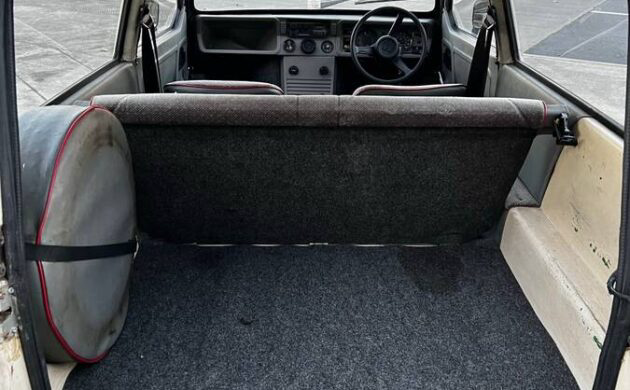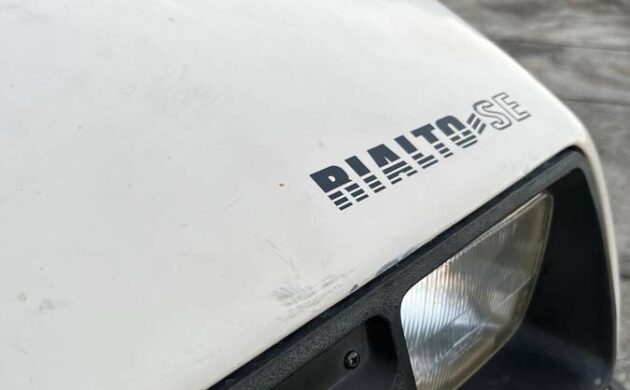Better Than a Trike: 1989 Reliant Rialto SE
Reliant might have been the oldest company that made the most models while still being obscure in the history of automaking. Founded in 1935 by Tom Lawrence Williams and E.S. Thompson, who built a prototype in Williams’ yard, Reliant went on to make cars up to February 2001. Most of its cars were three-wheelers, thanks to the founders’ experience at Raleigh Bicycle Company. (Raleigh was making the three-wheeled Ivy Karryall in 1935, which was basically a glorified motorcycle with a cargo compartment; Williams’ first car looked quite like the Karryall.) As Reliant matured, a few models were introduced in four-wheel configurations as the company attempted to appeal to new customers. Up until 1952, the cars were wood with aluminum panels, but as aluminum prices rose and fiberglass technology advanced, the company shifted strategies. By 1956 substantially all of the panels of its cars were fiberglass. Here on craigslist is a 1989 Reliant Rialto SE with an asking price of $11,500. The owner has had this car for a year and a half and “loved every second of it” – a strong endorsement. The car is located in Tualatin, Oregon. Thanks to Rocco B. for this unusual tip!
In the 1930s, Reliant was using the Austin 7 four-cylinder 747 cc engine. Austin ceased production of that powerplant and sold the tooling and rights to Reliant. By altering the engine just enough, Reliant assured that customers could no longer use Austin’s parts stash to fix their engines, guaranteeing a flow of orders for its own parts. As the motor evolved, an aluminum version arrived in 1962 with a 600 cc displacement. Displacement was enlarged several times due to complaints about lack of power until it reached 850 cc’s in 1975. Equipped with a single SU carburetor, this is likely the engine that sits in our subject car’s engine bay. The output is about 40 bhp, and the gearbox is a four-speed manual. The seller indicates that the Rialto’s odometer reads 89k. Despite the three wheels, handling is reputedly fine, though I can just imagine the arguments at a British car show around where that third wheel should be, with Reliant owners lined up on one side, and back-wheeled Berkeley T60, Morgan, and Peel owners lined up on the other side.
The SE model designation was used from 1986 on. By then, Reliant had reinforced the roof well enough to add a hatch to the rear – a very popular feature. These cars didn’t see a lot of export activity, so right-hand drive dominates the population of available Reliants. The seats are cloth and appear decent both front and back. The door panels are excellent, but the seller reports that the dash is cracked. Fortunately, abundant parts including a replacement dash come with the car.
The car has paint flaws in every corner, including a more severe insult on the roof. But it’s the kind of gentle patina that matches the few stains in the interior and the faded trim. A new paint job would only make everything else look really shabby. If you fancy three-wheelin’, bargaining is in order. Rialtos don’t sell for much, and this one is thus far priced for perfection.
Auctions Ending Soon
 2002 Subaru Impreza WRXBid Now2 days$333
2002 Subaru Impreza WRXBid Now2 days$333
 1975 Chevrolet Corvette ConvertibleBid Now2 days$4,000
1975 Chevrolet Corvette ConvertibleBid Now2 days$4,000
 1964 Ford F-100 Camper CustomBid Now2 days$2,000
1964 Ford F-100 Camper CustomBid Now2 days$2,000
 2006 Jeep Wrangler SportBid Now4 days$10,500
2006 Jeep Wrangler SportBid Now4 days$10,500
 1974 Datsun 260ZBid Now6 days$460
1974 Datsun 260ZBid Now6 days$460





Comments
Welcome to “Crazy Michelles Place of Automobiles”. Simpsons fans will recognize this one. The “car” Crazy Vaclav was trying to sell Homer, was in fact modeled after a Reliant Robin. “It goes 300 hectares on a single liter of kerosene”,,
3 wheelers, I read, escaped certain taxes that 4 wheeled cars had to pay. I’ve mentioned my dislike for 3 wheelers, as the single wheel always rides in the grease/nail strip. Since my road patience has grown thin, a short trip to Walmart is all I do, and you’ll see, people will eventually get fed up with $9,000 replacement “hemi” motors, and will gravitate to more simple means of travel. I just don’t know if people will spend 5 figures on one. We’ll see, eh?
https://www.youtube.com/watch?v=1HPVQ4FpVlY
“there’s no reverse” “Put it in H”
Howard… What, not mention of being dangerous or tipping over??? Had you done so, I would have agreed with you. But no… three wheels are not horrible as long as there are two in front and one in back! Your point of the one in the middle is well taken, but that just requires some re-learning, as would driving a motorcycle compared to a car. Personally, I am very interested in when the Aptera hits the market. It just might be the best 3 wheeler since the Morgan. BTW, I am surprised that you shop at Walmart, I never go there.
I saw an earlier version of this at a British car show.
I asked the owner if he had to wear a helmet while driving
it,as it was registered as with motorcycle plates.
He said he didn’t.
Probably a Robin.
Yes it was.
To see this car I am reminded how lucky I am to live in America where we take so much for granted. This is not meant to be a political rant but cars like this are a result of living in areas of high taxes and fuel prices. These and others became a necessity for the low to middle income families. They are a compromise when compared to even a car like a Vega or a Pinto or a Chevette. Imagine waiting for years to afford or purchase a eastern block vehicle. Crude to say the least. Makes even our crappiest cars seem like a a Lexus.
It’s British, not Eastern Block. But it was an economy car. Up to 70+ mpg. Driver’s licenses in the UK are very restricted. This was available to almost anyone to drive.
Interesting that almost anyone could drive these – I would think that one would need special training to understand how the single front wheel would change braking and handling. In the US we need a separate license to drive a motorcycle because they behave differently.
You have had worse cars than this in the USA. No-one has quite nailed the reasons for 3 wheelers in the UK. It goes back to pre-WW2 when most residents could not afford a car anyway.
Provided it weighed less than 450kg (990lbs) a 3 wheeler in the UK was classed like a motor cycle plus sidecar, meaning it could be driven on a motorbike license from age 16, cost less to tax & insure etc.
This remained true until about 10 years ago, and some people stayed loyal to the idea because they liked the cars. After the 1950s, very few people in the UK chose a 3 wheeler because they couldn’t afford a car.
I hate these things and they are death traps. I assume those who buy them are tired of life in any case….
Ride in a Trabant and you really appreciate what we take and took for granted.
Lovely little Brits. We enjoyed ours.
This car just looks so incredibly weird in that 3/4 profile picture. I guess it just goes against what has come to be our expectation of what a car should look like! :-)
Reminds me of the “Bond Bug” out of the U.K.
Cheers!
👍🤓🇬🇧🍺
Made by the same company, and largely the same car under the skin.
No Washington plates? Posted 11 days ago.
https://www.snotr.com/video/7266/Top_Gear_-_The_Reliant_Robin
As soon as I saw it my wind went straight to Jeremy Clarkson
Me too!
That whole episode was bogus—lying on tv, imagine that! It has been exposed that they rigged the car so it would roll.
My first thought also.
I can not believe it has 89,000 miles..
@Alphasud. yeah, the forum rules about not expressing political views are there for a reason, and as per “George” – kind of barking up the wrong tree. These were in the UK not East Germany. These were aimed at the economy end of the market for sure, but part of the attraction was the licensing and vehicle taxation rules, which taxed these more like motorcycles than cars, and allowed drivers who only had a motorcycle class license to drive one. nobody was forced to buy one by the state, there were a full range of vehicles of all levels available to the population.
When I saw this featured car, I did wonder how long it would take someone to cite Top Gear’s stunt with a Reliant Robin tipping over. I assume all folks are aware that stunt was staged, faked, the car was loaded with ballast on one side to force it to overbalance. like most stuff on Top Gear, scripted, staged.
I should not have referenced the eastern block as a comparison. I was trying to convey the high costs of vehicle ownership in the UK was the driving factor to create a 3 wheel car to get around tax penalties. We have been fortunate here with cheap fuel prices as compared to ROW. Our solutions to cheap transportation were not safe due to the laws of physics and lack of modern restraint systems and crumple zones. Compared to a 3-wheel fiberglass car they were more safe.
Too tippy in front for me, especially where I live (in the hills).
Almost makes me want to buy it just to cram a Harley Davidson drive train in it, because I need another death trap
Go for broke a put a Busa engine in it…lol
The engine could be effectively tuned. For many years it powered the 750MC series race cars. Doesn’t sound promising but a lot of the most famous UK race car designers started out in the category.
Gordon Murray has just restored his, the first car he built in the UK.
If you want to go quickly in one, you need to keep the back end moving.
Thru my ownership of Tatra cars, I got to know Tim Bishop, the senior design engineer at Reliant Motors in the late1980s, as he was also designing a fuel injection {PI} for the Tatra T-613 V8 so the car could meet the EU pollution requirements.
On arrival at the Reliant works in Tamworth, we had a wonderful tour of the factory. While visiting the engine assembly area, Tim picked up a bare 4 cylinder engine block with one hand. He said ‘Here, catch this” and he tossed it my way. On catching it and expecting it to be really heavy, I was amazed that the entire die-cast aluminum [aluminium in the UK] bare block weighed only 7 pounds [a little over 3 kilos]. Tim said that by keeping the mechanical equipment as light as possible, they were able to maintain the motorcycle weight classification in place.
Having always wanted to drive a Reliant 3 wheel car, Tim also tossed a set of keys my way, and off we went. I have to say that the little car was quite stable during my road test, perhaps because there were 3 adults in the car, but I’ve driven various European micro cars like the Isetta, and the Reliant handled just as well as the other small cars.
Would I want to drive it for long distances on America’s high speed roads? No more than I would with similar vintage small cars, that’s what car trailers are for! But as a local commuter vehicle for general town use, sure. Around 2001 I heard from Tim that Reliant was closing it’s plant, and going to assemble imported Italian Piaggio Ape 3 wheel micro vans instead.